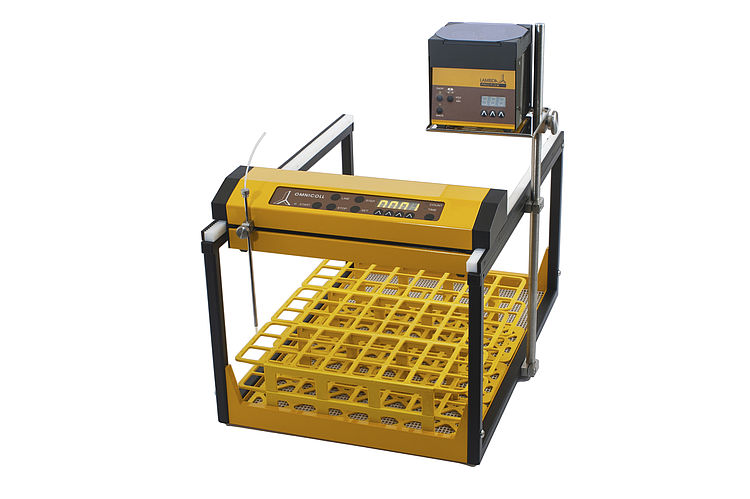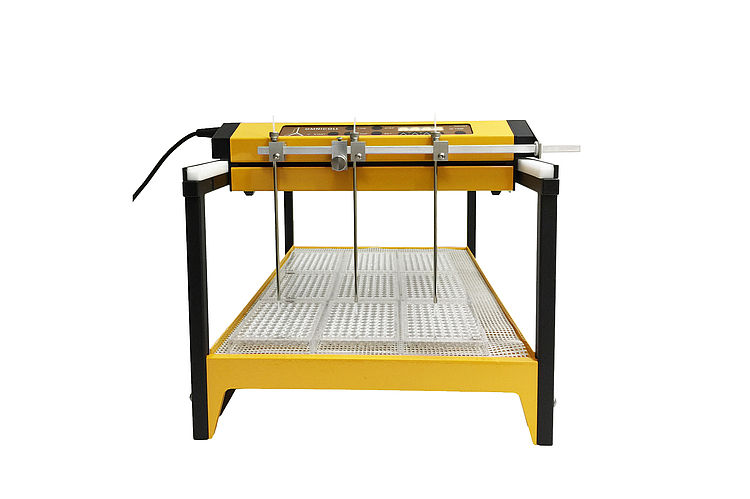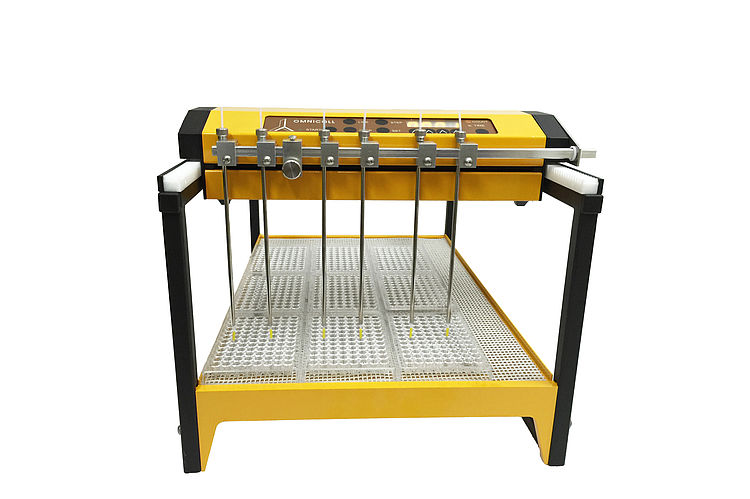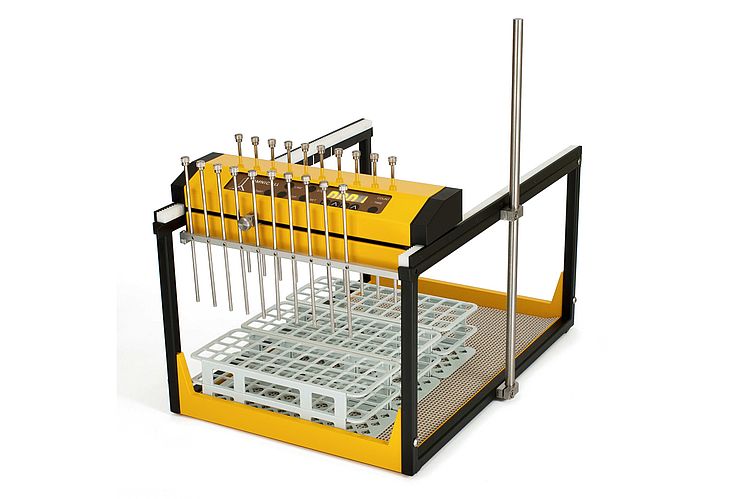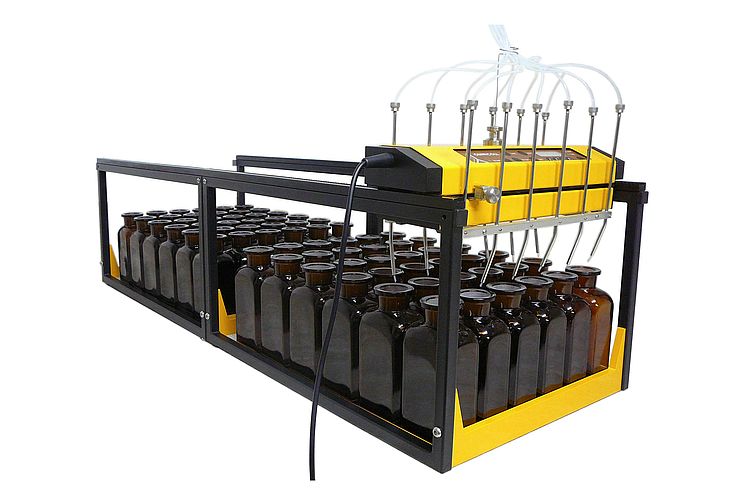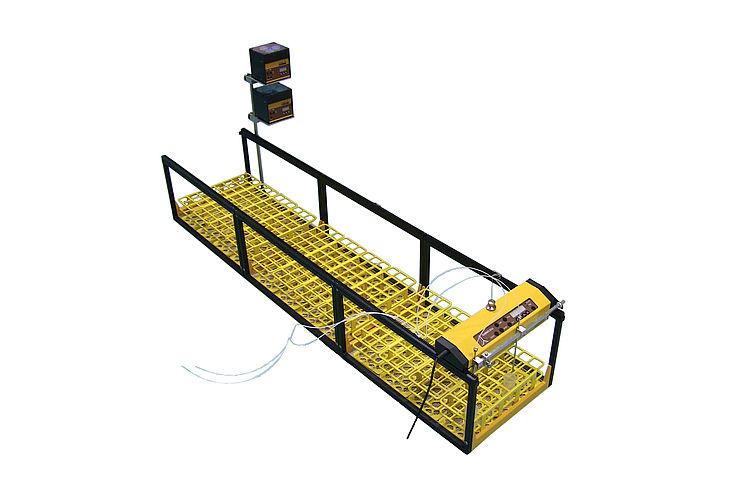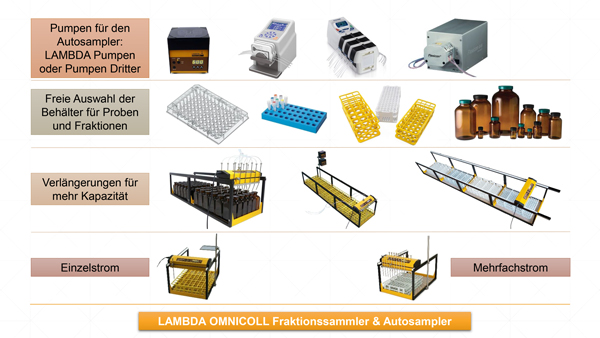Colector de Fracciones
Colector de Fracciones
Un nuevo concepto en colector de fracciones
Colector de fracciones LAMBDA OMNICOLL
Descripción de colector de fracciones
- recolección de fracciones en cualquier gradillas o recipiente elegido
- recoge un número ilimitado de fracciones o muestras
- electrónica y partes móviles están situadas sobre los recipientes/tubos:
- sin peligro para estas en caso de derrame
- puede colocarse en baño frío o en otro contenedor termo estabilizado - Colección de fracciones acorde con tiempo (0.1–999.9 min o 1–9999 min) o volumen (0.05–500 mL o 0.1–30 L)
- excelente calidad al precio justo
- construcción metálica resistente a solventes
- pausa (0–999.9 min ó 1–9999 min) o enjuague programable entre dos fracciones
- hasta 18 fracciones simultáneas, operación multi-canal (en opción)
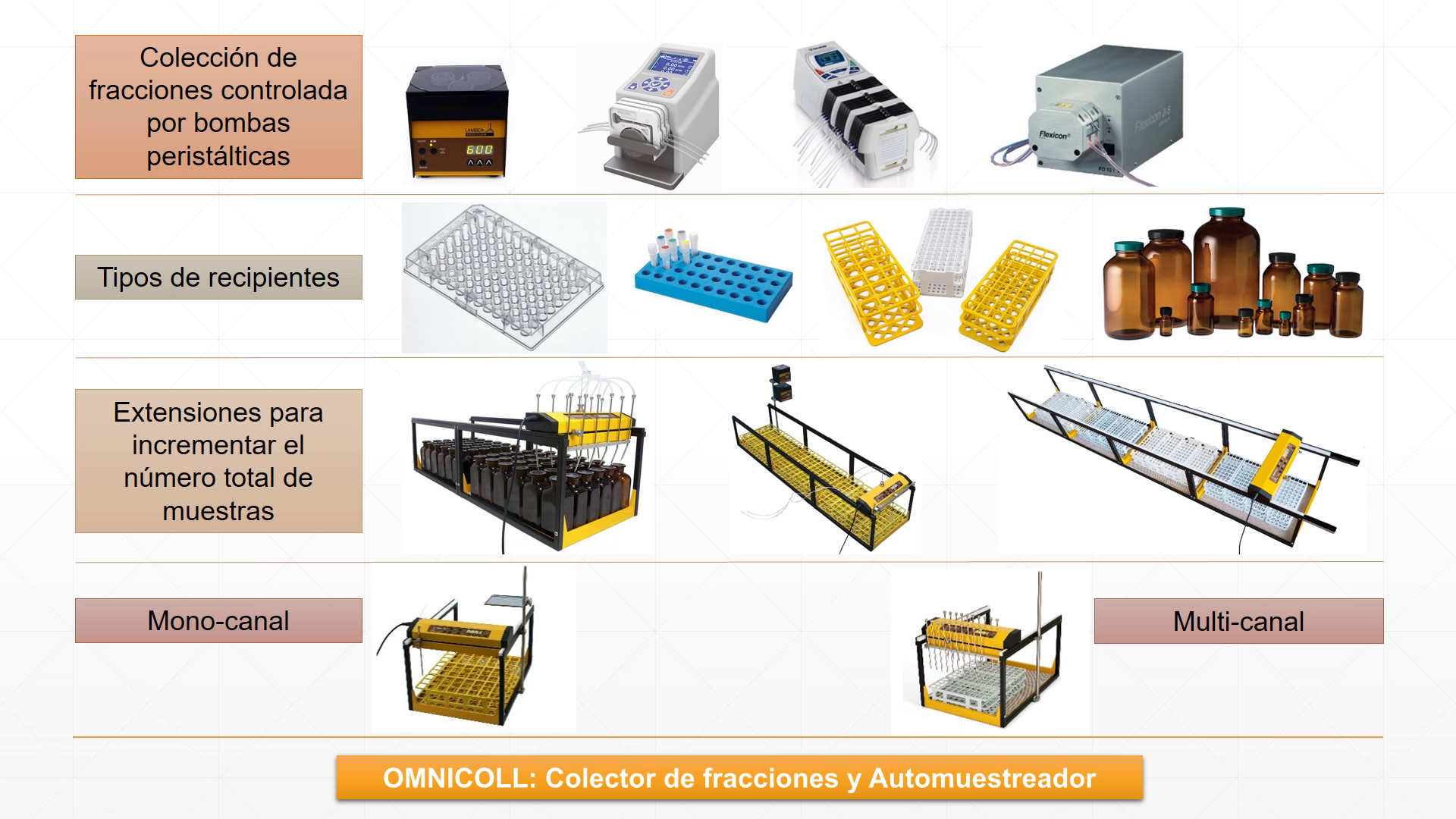
Dimensiones ilimitadas:
- Desde microplacas, vasos de precipitado, tubos Corning, frascos hasta botellas de gran volumen, etc.
- Colección de un número ilimitado de fracciones
Control muy flexible:
- Colección de fracciones por señal externa en función del volumen, tiempo y posibilidad de conteo de gotas
- Fácil programación y manejo
Colección de flujo único / flujos múltiples (multicanales):
- Flujo único
- Hasta 20 fracciones se pueden colectar en multiflujo de forma simultánea
| Colector de fracciones con un solo canal o flujo | Configuración del colector de fracciones para 4 canales | Configuración de 6 canales para microplacas de 96 pozos |
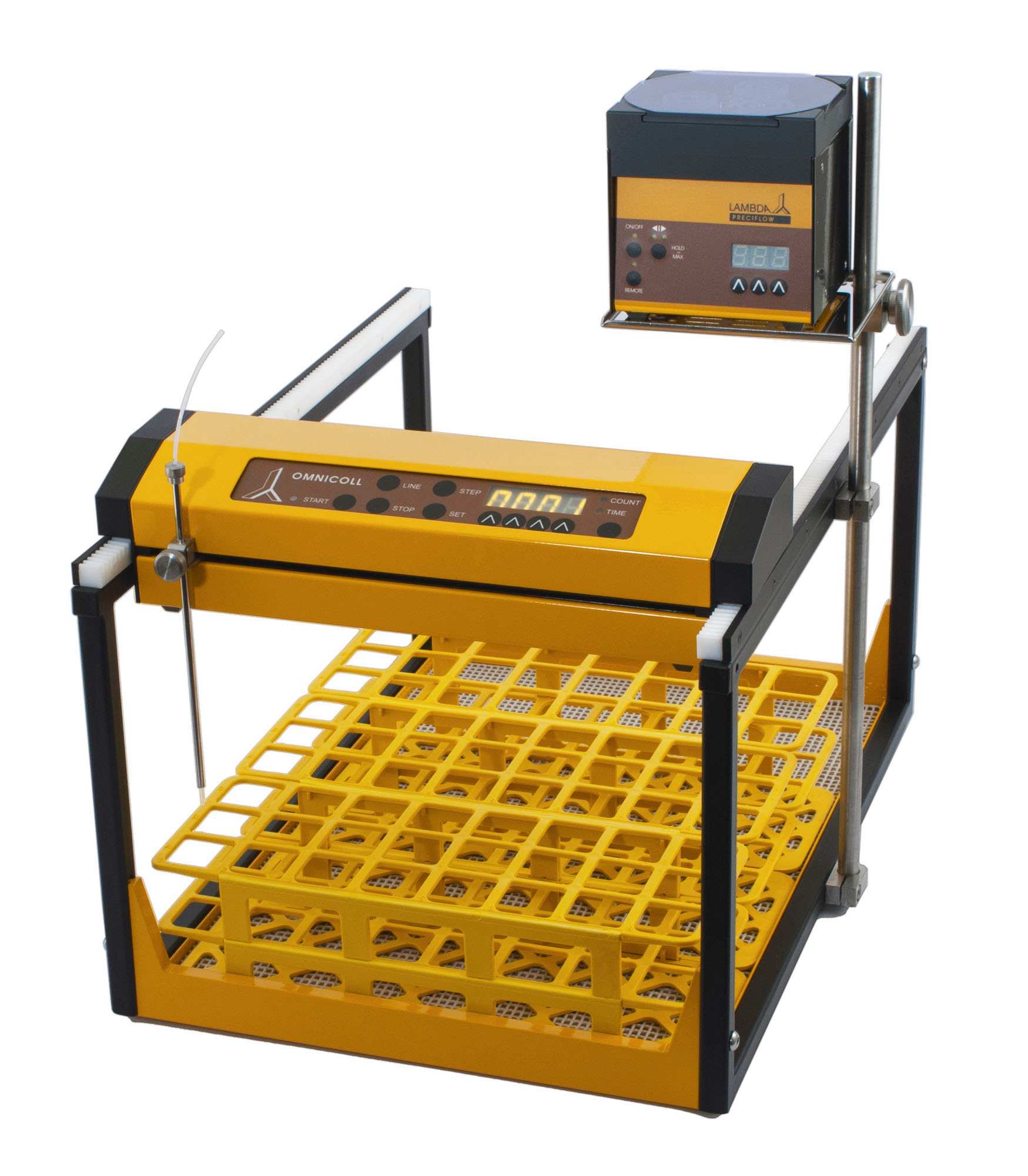 |
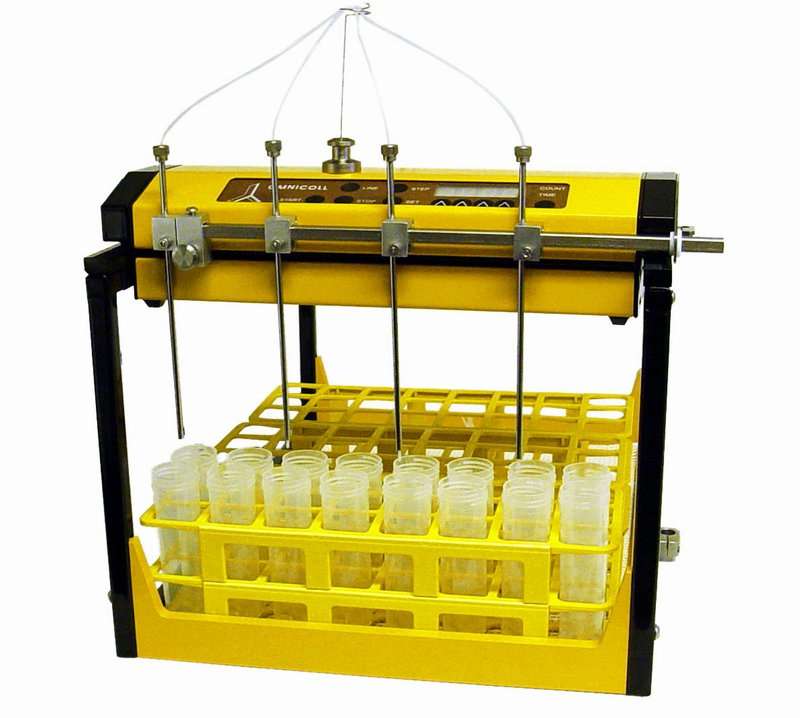 |
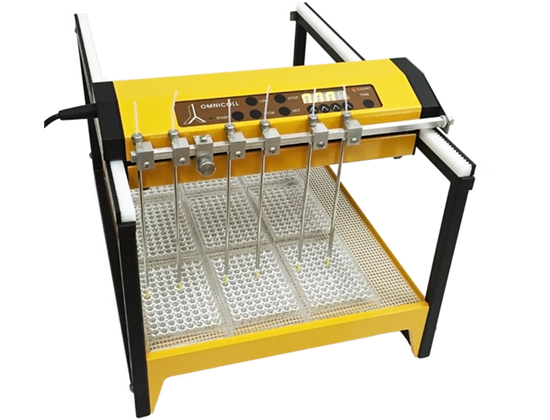 |
Características del colector de fracciones y muestras LAMBDA OMNICOLL
- Único colector de fracciones fácilmente programable para cualquier gradilla o recipiente seleccionado.
- Componentes electrónicos y mecánicos miniaturizados colocados en la parte móvil situada sobre los tubos. Sin peligro de derrame de líquido sobre estos.
- La base puede ser colocada en un baño frío o cualquier otro contenedor termo estabilizado.
- Sistema de control que posee un moderno microprocesador con varios sensores ópticos, que con una simple marca de lápiz corrector permite la fácil programación de la posición de los tubos.
- Recolección de fracciones según tiempo o volumen
- Recolección de fracciones en línea o en zig-zag
- Posibilidad de programación de una pausa entre fracciones (0.1-999.9 minutos o 1-9999 minutos). El colector de muestras OMNICOLL es utilizado en la toma de muestras (simples o múltiples) en procesos de fermentación, cultivo celular y en otros procesos biológicos o químicos.
- La función de pausa puede utilizarse también para la puesta en marcha automática del colector de muestras.
- Elección del número de fracciones en una serie, así es posible enjuagar la manguera entre cada muestra.
- Con función “auto-stop” que apaga el colector automáticamente y detiene la recolección de muestras después de la gradilla seleccionada o al final de una línea.
- Detención de caudal de bomba, que impide el derramamiento de líquido entre fracciones consecutivas.
- La pieza móvil en este caso es la manguera de transferencia de líquidos y no los tubos. Así, se requiere menos energía y se logra la miniaturización del colector. Además, los tubos son fácilmente accesibles desde cualquier ángulo.
- La base del colector puede ser utilizada para el transporte o almacenaje de fracciones. Un nuevo tapete plástico mantiene las gradillas o los recipientes en su posición.
- Pueden usarse varias bases para incrementar la capacidad de recolección del colector de fracciones.
- Trabaja a bajo voltaje para mayor seguridad del usuario. Fácil utilización en aplicaciones de campo de forma sencilla, ya que puede operar con batería.
- Su sólida construcción metálica hace el colector de fracciones y muestreador resistente a solventes.
- De fácil montaje y desmontaje. Requiere mínimo espacio de almacenamiento.
- Por su construcción, el colector de muestras no requiere de un mantenimiento especial.
- Excelente relación calidad - precio
- Control remoto que permite la toma de muestras después de la recepción de una señal externa (p. ej. una alarma). Así, es posible obtener muestras importantes durante un proceso de larga duración, incluso sin supervisión.
- Contador de gotas, válvula inerte, interfaz RS-232 y otros accesorios también se encuentran disponibles.
Modo de colección: Lineal (línea), meandro (zigzag) o en fila
Modo Normal:
Tiempo: 0.1 a 999.9 minutos (16.67 horas) en pasos de 0.1 min o 1 a 9999 minutos (166.7 horas) en pasos de 1 min
Volumen: 0.01 a 500 mL o 0.6 a 30 L (conteos externos empleando una bomba peristáltica LAMBDA)
Modo Alto: Similar a modo Normal pero con una pausa entre las fracciones (desde 0.1 a 999.9 min ó 1 a 9999 min)
Control remoto:
Modo Normal: Colector toma 1 única fracción después un pulso de voltaje externo de 3-12 V (12-30 V con un resistor de 3300 ohm)
Modo Alto: Colector toma fracciones de 1 a 999 después un pulso de voltaje externo de 3-12 V (12-30 V con un resistor de 3300 ohm)
Capacidad: Cualquier gradilla o contenedor con superficie menor de 45x31cm
Utilizando las gradillas suministradas: 360 tubos de 12-13 mm diámetro; 240 tubos de 16 mm diámetro; 160 tubos de 20 mm diámetro; 96 tubos de 30 mm diámetro; La capacidad se puede incrementar varias veces acoplando varias partes o soportes inferiores del colector.
Memoria no volátil: Almacena todos los datos
Interfaz: RS-232 (opcional)
Fuente de energía: 95–240 V/60–50 Hz AC conector a fuente de energía con salida a CD 9V/12W; posibilidad de operación en campo con el uso de una batería de 12 V
Dimensiones: 34 (A) x 30 (H) x 49 (P) cm
Peso: 6.5 Kg
Seguridad: Conforme a la CE, conforme con la norma IEC 1010/1 para instrumentos de laboratorio
Temperatura de operación: 0-40 °C
Humedad de operación: 0-90% HR, sin condensación
Control remoto: 0-10 V; (opción 0-20 o 4-20 mA)
- EN - OMNICOLL fraction collector and sampler - Leaflet (pdf)
- EN - Operation manual - OMNICOLL fraction collector and sampler (pdf)
- DE - Broschüre OMNICOLL Fraktionssammler und Probenehmer - Prospekt (pdf)
- DE - Bedienungsanleitung OMNICOLL Fraktionssammler und Probenehmer (pdf)
- FR - OMNICOLL collecteur de fractions et d'échantillons - brochure (pdf)
- FR - Manuel d’utilisation - Collecteur de fractions et échantillonneur OMNICOLL (pdf)
- CZ - OMNICOLL sběrač frakcí - leták (pdf)
- CZ - Návod - OMNICOLL sběrač frakcí (pdf)
- RU - Коллектор фракций и автосамплер LAMBDA OMNICOLL - листовка (pdf)
- RU - Коллектор фракций и автосамплер LAMBDA OMNICOLL - руководство по эксплуатации (pdf)
- ES - Manual de instrucciones - Colector de fracciones y muestras LAMBDA OMNICOLL (pdf)
- ES - OMNICOLL - colector de fracciones y muestreador - folleto (pdf)
- IT - Manuale operativo - LAMBDA OMNICOLL raccoglitore di frazioni-campionatore (pdf)
2024
Cromatografía en columna de intercambio iónico: Se utilizó el LAMBDA OMNICOLL para recoger fracciones de 40 ml.
Riemersma, M.C. (2024). Separation of terbium from gadolinium by solvent extraction, Upscaling terbium production for use in radionuclide therapy. TU Delft, Applied Sciences, Master thesis.
https://resolver.tudelft.nl/uuid:d2dcd756-a4d2-4d3a-8709-7c537f41796b (Nov. 08, 2024)
Adsorción dinámica por membrana (modo de flujo continuo, área de filtración de 3.8 cm2): Los experimentos dinámicos de paso para investigar la influencia del flujo, el NaCl y el pH se realizaron por duplicado y el permeado se recogió mediante un muestreador de fracciones automatizado LAMBDA OMNICOLL.
Wullenweber, J., Bennert, J., Mantel, T., & Ernst, M. (2024). Characterizing Macroporous Ion Exchange Membrane Adsorbers for Natural Organic Matter (NOM) Removal—Adsorption and Regeneration Behavior. Membranes, 14(6), 124.
https://doi.org/10.3390/membranes14060124
LAMBDA OMNICOLL facilita la recuperación de fracciones desorbidas en una instalación de adsorción-desorción de lecho fijo (prototipo industrial con dos columnas de cromatografía empaquetadas (acero inoxidable, 50 mm × 20 mm, volumen del lecho 15.71 ml).
Bzainia, A., Igrejas, G., Pereira, M. J. V., Costa, M. R. P., & Dias, R. C. (2024). Purification of stilbenes from grape stems in a continuous process based on photo-molecularly imprinted adsorbents and hydroalcoholic solvents. Separation and Purification Technology, 127798.
https://doi.org/10.1016/j.seppur.2024.127798
2023
El sistema de sorción estaba compuesto por una bomba peristáltica Ismatec IPC8 (caudal 7.5 ml/h), una columna de sorción de vidrio (diámetro 15 mm; 5 ml de resina de intercambio iónico ) y un colector automático de fracciones LAMBDA OMNICOLL.
Skripchenko, S. Y., Nalivaiko, K. A., Titova, S. M., Rychkov, V. N., & Semenishchev, V. S. (2023). Recovery of uranium from conversion production sludge by leaching with nitric acid and subsequent ion-exchange concentration. Hydrometallurgy, 106255.
https://doi.org/10.1016/j.hydromet.2023.106255
En cada intervalo de tiempo de 10 minutos, el efluente de la columna se recogió en viales de 5 ml utilizando un colector de fracciones LAMBDA OMNICOLL.
Choudhary, A., Khandelwal, N., Ganie, Z. A., & Darbha, G. K. (2023). Influence of magnetite and its weathering originated maghemite and hematite minerals on sedimentation and transport of nanoplastics in the aqueous and subsurface environments. Science of The Total Environment, 169132.
https://doi.org/10.1016/j.scitotenv.2023.169132
LAMBDA OMNICOLL utilizado para cromatografía en columna en el "Environmental Nanoscience Laboratory, Darbha's research group":
https://gkdarbha.wixsite.com/gopaladarbha/instrumentation (2024 Jan. 03)
https://static.wixstatic.com/media/11a26b_72ea880a9edb434ca34e530fef35c200~mv2.jpg (2024 Jan. 03)
https://static.wixstatic.com/media/11a26b_60f73569d1e443da848c87333dc7d8ca~mv2.png/v1/fill/w_532,h_552,al_c,lg_1,q_85,enc_auto/fraction%20pump.png (2024 Jan. 03)
Colector de fracciones LAMBDA OMNICOLL equipado con bomba peristáltica: Para cada columna de suelos (largo de 22 cm, diámetro interno de 2.5 cm) se recolectaron 120 fracciones con un volumen de 3 ml por fracción.
Pena Silva, S. M. (2023). Estudio de los procesos de adsorción/desorción de 2-isopropil-6-metil-4-pirimidinol (IMPH) y 3, 5, 6-tricloro-2-piridinol (TCP) en montmorillonita pilarizada mediante la inclusión de especies de [Fe, Al], Zr y Ti y su potencial uso en la mitigación de lixiviación desde suelos agrícolas.
https://repositorio.uchile.cl/handle/2250/195796 (01. December 2023)
Cromatografía de permeación en gel (GPC) con columna Superose 6 Increase 10/300 GL (GE Healthcare) en un sistema HPLC (Agilent/Varian Prostar 210): Las fracciones se recogieron en placas de 96 pocillos de fondo plano (Costar 3599, Corning), en el punto de tiempo de inyección a 0.5 ml por fracción utilizando un colector de fracciones LAMBDA OMNICOLL.
Wannitikul, P., Wattana-Amorn, P., Sathitnaitham, S., Sakulkoo, J., Suttangkakul, A., Wonnapinij, P., W. Bassel, G.W., Simister, R., Leonardo D., Gomez, L.D & Vuttipongchaikij, S. (2023). Disruption of a DUF247 Containing Protein Alters Cell Wall Polysaccharides and Reduces Growth in Arabidopsis. Plants, 12(10), 1977.
https://doi.org/10.3390/plants12101977
Recogida simultánea de fracciones: A intervalos de cinco minutos, se recogieron muestras simultáneamente de cuatro salidas de columna utilizando un colector de fracciones automático LAMBDA OMNICOLL.
Abdelrady, A., Tang, Y., Bogaard, T. & Foppen, J. W. (2023). The Use of Silica Encapsulated DNA Particles with a Supermagnetic Iron Core (Sidnamag) in Sand Filtration System: Effect of Water Chemistry. Available at SSRN 4555357.
https://dx.doi.org/10.2139/ssrn.4555357
Experimentos de DNAcol con arena lavada con ácido (2.65 g/cm3), columna (2.7 x 8 cm), flujo ascendente (0.40 ml/min): El efluente se recogió continuamente con un período de muestreo de 5 min utilizando un colector de fracciones LAMBDA OMNICOLL.
Kianfar, B., Hassanizadeh, S. M., Abdelrady, A., Bogaard, T., & Foppen, J. W. (2023). Natural organic matter and ionic strength (CaCl2) affect transport, retention and remobilization of silica encapsulated DNA colloids (DNAcol) in saturated sand columns. Colloids and Surfaces A: Physicochemical and Engineering Aspects, 678, 132476.
https://doi.org/10.1016/j.colsurfa.2023.132476
Reacciones electroquímicas en configuraciones de flujo con válvula de conmutación y colector de fracciones LAMBDA OMNICOLL (que se puede operar con recipientes de recolección de diferentes tamaños) como equipo periférico para recolectar electrolito.
Hielscher, M. M., Dörr, M., Schneider, J. & Waldvogel S. R. (2023). LABS: Laboratory Automation and Batch Scheduling – A Modular Open Source Python Program for the Control of Automated Electrochemical Synthesis with a Web Interface. Chem. Asian J. 2023, e202300380.
https://doi.org/10.1002/asia.202300380
Influencia de los tensioactivos SDS y TX-100 en el transporte vertical del metabolito fungicida OH-CTL: en la parte superior de las columnas (1.8 cm (id) x 20 cm (h) de PMMA, relleno de 18 cm (h) de suelo saturado de agua y capa superior de suelo modificado con tensioactivos), se aplicaron 4 ml de solución de OH-CTL (40 µg/ml de hidroxiclorotalonil en agua) a un caudal constante de 1 ml/min. A continuación, se realizó una lixiviación continua con 1 ml/min de agua (UPW) hasta que se recogieron al menos 10 o 40 volúmenes de poros. Las fracciones se tomaron en un colector de fracciones automatizado LAMBDA OMNICOLL.
Báez, M. E., Sarkar, B., Peña, A., Vidal, J., Espinoza, J., & Fuentes, E. (2023). Effect of surfactants on the sorption-desorption, degradation, and transport of chlorothalonil and hydroxy-chlorothalonil in agricultural soils. Environmental Pollution, 327, 121545.
https://doi.org/10.1016/j.envpol.2023.121545
2022
Pruebas de adsorción en columnas de arena (PMMA, 3.2 cm de diámetro x 7.0 cm de longitud): El efluente se recogió con un colector de fracciones LAMBDA OMNICOLL para determinar las concentraciones de Zn y Fe.
Krok, B., Mohammadian, S., Noll, H. M., Surau, C., Markwort, S., Fritzsche, A., Fritzsche, A., Nachev, M., Sures, B. & Meckenstock, R. U. (2022). Remediation of zinc-contaminated groundwater by iron oxide in situ adsorption barriers–From lab to the field. Science of The Total Environment, 807, 151066.
https://doi.org/10.1016/j.scitotenv.2021.151066
Las muestras se recogieron simultáneamente de la parte superior de dos columnas de PVC (15 cm, ID 2.1 cm; Milder) empaquetadas con arena de cuarzo de 355-425 µm de diámetro de grano (Sibelco) utilizando un colector automático de fracciones LAMBDA OMNICOLL.
Chakraborty, S., Foppen, J. W., & Schijven, J. F. (2022). Effect of concentration of silica encapsulated ds-DNA colloidal microparticles on their transport through saturated porous media. Colloids and Surfaces A: Physicochemical and Engineering Aspects, Volume 651, 2022, 129625.
https://doi.org/10.1016/j.colsurfa.2022.129625
Se colocó un colector de fracciones LAMBDA OMNICOLL a la salida de la columna de vidrio Omnifit (longitud = 20 cm, diámetro interior = 2.5 cm, piezas terminales de PTFE) para recuperar las fracciones efluentes antes de los análisis posteriores.
Cazals, F., Colombano, S., Huguenot, D., Betelu, S., Galopin, N., Perrault, A., Simonnot, M.-O., Ignatiadis, I., Rossano, S. & Crampon, M. (2022). Polycyclic aromatic hydrocarbons remobilization from contaminated porous media by (bio) surfactants washing. Journal of Contaminant Hydrology, 251, 104065.
https://doi.org/10.1016/j.jconhyd.2022.104065
La velocidad de flujo se mantuvo utilizando una bomba peristáltica. Los efluentes tratados se recogieron a intervalos de tiempo establecidos utilizando un colector de fracciones programable (colector de un solo canal LAMBDA OMNICOLL).
Feizi, F., Sarmah, A. K., Rangsivek, R. & Gobindlal, K. (2022). Adsorptive removal of propranolol under fixed-bed column using magnetic tyre char: Effects of wastewater effluent organic matter and ball milling. Environmental Pollution, Volume 305, 2022, 119283, ISSN 0269-7491.
https://doi.org/10.1016/j.envpol.2022.119283
Los efluentes se recolectaron en incrementos de 2 h (correspondientes a 7.5 PV, aprox. 5.4 ml) usando un colector de fracciones (Lambda Omnicoll), sellados en botellas de PP y refrigerados hasta el análisis.
Perdrial, N., Vázquez-Ortega, A., Reinoso-Maset, E., O'Day, P. A. & Chorover, J. (2022). Effects of flow on uranium speciation in soils impacted by acidic waste fluids. Journal of Environmental Radioactivity, Volumes 251–252, 2022, 106955, ISSN 0265-931X.
https://doi.org/10.1016/j.jenvrad.2022.106955
Los experimentos de sorción dinámica se realizaron en una columna de lecho fijo con 5 ml de resina RUA21207. La solución se pasó a través de una columna a un caudal de 10 ml/h. Se tomaron muestras de la solución a intervalos regulares (1 h) utilizando el colector de fracciones y automuestreador LAMBDA OMNICOLL.
Smyshlyaev, D., Kirillov, E., Kirillov, S., Bunkov, G., Rychkov, V., Botalov, M., Taukin, A., Yuldashbaeva, A. & Malyshev, A. (2022). Recovery and separation of Sc, Zr and Ti from acidic sulfate solutions for high purity scandium oxide production: Laboratory and pilot study. Hydrometallurgy, Volume 211, 2022, 105889, ISSN 0304-386X.
https://doi.org/10.1016/j.hydromet.2022.105889
Estudio de sorción de varias resinas en condiciones dinámicas al pasar a través de una columna de intercambio iónico; las muestras fueron tomadas por el colector de fracciones LAMBDA OMNICOLL.
Oqilov, B. R., Botalov, M. S., Rychkov, V. N., & Kirillov, E. V. (2022, June). Study of sorption leaching of scandium from red mud with Succinic acid. In AIP Conference Proceedings (Vol. 2466, No. 1, p. 050025). AIP Publishing LLC.
https://doi.org/10.1063/5.0092655
El efluente se muestreó automáticamente en fracciones de 10 mL utilizando un colector de fracciones LAMBDA OMNICOLL. También se estudió la desorción de iones de metales pesados en condiciones dinámicas pasando una solución acuosa de HCl 0.1 M a través de la columna a un caudal de 1 mL/min.
Dinu, M. V., Humelnicu, I., Ghiorghita, C. A., & Humelnicu, D. (2022). Aminopolycarboxylic acids-functionalized chitosan-based composite cryogels as valuable heavy metal ions sorbents: Fixed-bed column studies and theoretical analysis. Gels, 8(4), 221.
https://doi.org/10.3390/gels8040221
Los experimentos de columna de suelo se realizaron con columnas de cromatografía de altura ajustable, hechas de vidrio de borosilicato. Para cada experimento, se recogieron ~ 0.8 ml del efluente de la columna en un tubo de centrífuga de 20 ml utilizando un colector de fracciones LAMBDA OMNICOLL.
Kianfar, B., Tian, J., Rozemeijer, J., van der Zaan, B., Bogaard, T. A., & Foppen, J. W. (2022). Transport characteristics of DNA-tagged silica colloids as a colloidal tracer in saturated sand columns; role of solution chemistry, flow velocity, and sand grain size. Journal of Contaminant Hydrology, 246, 103954
https://doi.org/10.1016/j.jconhyd.2022.103954
La sorción de uranio a partir de soluciones modelo en modo estático se llevó a cabo mediante el uso de intercambiadores de aniones. El volumen de resina cargado en la columna fue de 5 ml, la velocidad de filtración de la solución a través de la capa de resina fue de 5 volúmenes de lecho durante 1 hora. Se tomaron muestras del filtrado a la salida de la columna mediante el uso de un colector automático de fracciones LAMBDA OMNICOLL.
Nalivaiko, K., Skripchenko, S., Titova, S., & Rychkov, V. (2022). Characterization and processing of radioactive uranium containing waste sludge by sulfuric acid leaching. Journal of Environmental Chemical Engineering, 10(1), 106972.
https://doi.org/10.1016/j.jece.2021.106972
Durante el proceso de fusión del núcleo de firn en una cabina limpia (ISO 5), se recogió la corriente de muestra restante del depurador con un colector de fracciones líquidas LAMBDA OMNICOLL (~0.7 ml/min) como archivo del agua de fusión.
Seokhyun Ro, S., Hur, S. D., Hong, S., Chang, Ch., Moon, J., Han, Y., Jun, S. J., Hwang, H. & Hong, S. (2020). An improved ion chromatography system coupled with a melter for highresolution ionic species reconstruction in Antarctic firn cores. Microchemical Journal, Elsevier, MICROC 105377
https://doi.org/10.1016/j.microc.2020.105377
2021
Colector monocanal LAMBDA OMNICOLL programado para recoger 3 ml de soluciones acuosas a la salida de una columna en intervalos de tiempo establecidos.
Feizi, F., Sarmah,A.K. & Rangsivek, R. (2021). Adsorption of pharmaceuticals in a fixed-bed column using tyre-based activated carbon: Experimental investigations and numerical modelling. Journal of Hazardous Materials, 2021.
https://doi.org/10.1016/j.jhazmat.2021.126010
Las soluciones de efluentes se recogieron con el colector de fracciones LAMBDA OMNICOLL.
Vázquez-Ortega, A., Perdrial, N., Reinoso-Maset, E., Root, R. A., O’Day, P. A. & Chorover, J. (2021). Phosphate controls uranium release from acidic waste-weathered Hanford sediments. Journal of Hazardous Materials, Volume 416, 2021, 126240, ISSN 0304-3894.
https://doi.org/10.1016/j.jhazmat.2021.126240
El eluido se recogió utilizando el colector de fracciones LAMBDA OMNICOLL en viales de 15 mL a intervalos regulares de tiempo y se analizaron las concentraciones en los efluentes.
Khandelwal, N., Tiwari, E., Singh, N., & Darbha, G. K. (2021). Heterogeneously Porous Multiadsorbent Clay–Biochar Surface to Support Redox-Sensitive Nanoparticles: Applications of Novel Clay–Biochar–Nanoscale Zerovalent Iron Nanotrident (C-BC-nZVI) in Continuous Water Filtration. ACS ES&T Water, 1(3), 641-652.
https://doi.org/10.1021/acsestwater.0c00147
Estudios dinámicos de sorción: el colector de fracciones LAMBDA OMNICOLL recogió muestras de efluentes cada 15 min. La elución de los iones de metales pesados (HMI) se realizó haciendo pasar HCl 0.1 M a través de la columna de lecho fijo con una velocidad de flujo de 0.42 ml/min.
Humelnicu, D., Dragan, E. S., Ignat, M., & Dinu, M. V. (2020). A comparative study on Cu2+, Zn2+, Ni2+, Fe3+, and Cr3+ metal ions removal from industrial wastewaters by chitosan-based composite cryogels. Molecules, 25(11), 2664.
https://doi.org/10.3390/molecules25112664
LAMBDA OMNICOLL conectado a una columna HPLC - mediante una válvula y un capilar - para recoger fracciones de 2 ml en 96 pequeños viales de centelleo (capacidad de ~6 ml).
Gaugler, P., Gaugler, V., Kamleitner, M., & Schaaf, G. (2020). Extraction and quantification of soluble, radiolabeled inositol polyphosphates from different plant species using SAX-HPLC. JoVE (Journal of Visualized Experiments), (160), e61495.
El colector de fracciones LAMBDA OMNICOLL permite el muestreo a intervalos de profundidad definidos. Se colocó en una campana que utiliza Argón para evitar la reoxidación de las muestras.
Schroeder, H., Duester, L., Fabricius, A. L., Ecker, D., Breitung, V., & Ternes, T. A. (2020). Sediment water (interface) mobility of metal (loid) s and nutrients under undisturbed conditions and during resuspension. Journal of hazardous materials, 394, 122543.
https://doi.org/10.1016/j.jhazmat.2020.122543
2019
Las fracciones de perifusato se recogieron con un sistema automatizado de recogida de fracciones LAMBDA OMNICOLL en placas MASTERBLOCK de 96 pocillos (Greiner bio-one) y al final del experimento se almacenaron a -80 °C.
Barlow, J., & Solomon, T. P. (2019). Conditioned media from contracting skeletal muscle potentiates insulin secretion and enhances mitochondrial energy metabolism of pancreatic beta-cells. Metabolism, 91, 1-9.
https://doi.org/10.1016/j.metabol.2018.11.004
Para estudiar el impacto de la perturbación mecánica y la acidificación sobre el metal(loide), se utiliza el colector de fracciones LAMBDA OMNICOLL para recoger 12 perfiles de 22 muestras durante cada experimento.
Schroeder, H., Fabricius, A. L., Ecker, D., Ternes, T. A., & Duester, L. (2019). Impact of mechanical disturbance and acidification on the metal (loid) and C, P, S mobility at the sediment water interface examined using a fractionation meso profiling ICP-QQQ-MS approach. Science of the Total Environment, 651, 2130-2138.
https://doi.org/10.1016/j.scitotenv.2018.09.390
2017
Colector de fracciones LAMBDA OMNICOLL y bomba peristáltica LAMBDA PRECIFLOW colocados en una caja de guantes bajo atmósfera de argón en un novedoso sistema de muestreo y perfilado meso (messy) para estudios biogeoquímicos de la contaminación del agua.
Schroeder, H., Fabricius, A. L., Ecker, D., Ternes, T. A., & Duester, L. (2017). Metal (loid) speciation and size fractionation in sediment pore water depth profiles examined with a new meso profiling system. Chemosphere, 179, 185-193.
https://doi.org/10.1016/j.chemosphere.2017.03.080
2016
Colección automática de las muestras (10 ml/min) por el colector LAMBDA OMNICOLL a partir de una columna de cama empacada para evaluar el transporte potencial de suspensiones de partículas ZVI molidas estabilizadas
Velimirovic, M., Schmid, D., Wagner, S., Micić, V., von der Kammer, F., & Hofmann, T. (2016). Agar agar-stabilized milled zerovalent iron particles for in situ groundwater remediation. Science of The Total Environment, 563, 713-723.
https://doi.org/10.1016/j.scitotenv.2015.11.007
Helmholtz-Centre for Environmental Research - UFZ, Germany; University of Vienna, Austria
2015
Muestras efluentes se colectaron a partir de una columna de cama fija empleando el colector de fracciones OMNICOLL LAMBDA en arreglo multicanal para estudiar la adsorción de selenito y selenato por Mg-Al-CO3 LDH en sistemas de flujo contínuo
Chubar, N. & Szlachta, M. (2015). Static and dynamic adsorptive removal of selenite and selenate by alkoxide-free sol–gel-generated Mg–Al–CO3 layered double hydroxide: Effect of competing ions. Chemical Engineering Journal 279 (2015): 885-896.
https://doi.org/10.1016/j.cej.2015.05.070
Utrecht University, The Netherlands; Glasgow Caledonian University, UK and Wrocław University of Technology, Poland.
2014
Recobrado de eluatos o fracciones de una columna cromatográfica de vidrio para estudiar las reacciones de intercambio de iones entre Na+, H+, and Ca2+ bajo condiciones dinámicas.
Lu, J., Tertre, E., & Beaucaire, C. (2014). Assessment of a predictive model to describe the migration of major inorganic cations in a Bt soil horizon. Applied Geochemistry, Volume 41, February 2014, Pages 151-162.
https://doi.org/10.1016/j.apgeochem.2013.12.009
CEA, DANS/DPC/SECR/L3MR and Université de Poitiers-CNRS, France.
2013
Colección o toma de efluentes a partir de una columna de vidrio llenada con Bt horizon de suelos naturales y analizados por cromatografía de intercambio iónico para estudiar la adsorción de los cationes (Ca, Na) en sedimentos naturales
Lu, J., Beaucaire, C., & Tertre, E. (2013). Predictive model for migration of metallic cations in natural sediments. Procedia Earth and Planetary Science, 7, 529-532.
https://doi.org/10.1016/j.proeps.2013.03.059
CEA, DANS/DPC/SECR/L3MR and Université de Poitiers-CNRS, France.
2012
El colector de fracciones fue utilizado para colectar los eluyentes a partir de sedimentos contaminados empacados en una columna PEEK para determinar el pH y 90Sr por centelleo líquido
Eagling, J. (2012). The effect of sea level rise on radionuclide mobility at contaminated nuclear sites (Doctoral dissertation, University of Plymouth).
https://dx.doi.org/10.24382/3421
Plymouth University, UK
Colección de eluatos de 1.2 − 3.6 ml a partir de una columna empacada de sedimentos contaminados para la investigación de la movilización de Tc bajo condiciones de total saturación con flujos de agua de mar
Eagling, J., Worsfold, P. J., Blake, W. H., & Keith-Roach, M. J. (2012). Mobilization of technetium from reduced sediments under seawater inundation and intrusion scenarios. Environmental science & technology, 46(21), 11798-11803.
https://doi.org/10.1021/es3025935
Plymouth University, UK
2010
Toma de eluatos para determinar la liberación de iones de plata a partir de catéteres recubiertos
Aylvin Jorge Angelo Athanasius Dias, Edith Elisabeth M. Van Den Bosch, Astrid Franken (2010), Antimicrobial coating, US Patent no. US 2010/0113871 A1.
https://patents.google.com/patent/US20100113871
Can OMNICOLL replace the LKB Superfrac fraction collector (GE HealthCare) which is no longer available?
Yes, OMNICOLL fraction collector and sampler could replace Superfrac (also fraction collector Frac-950, Frac-920).
Do you also sell different heads to the collector that would allow collection into multiple racks at once?
We have a special customization for collecting fractions into multiple racks at once i.e. multi-stream configuration.
Do you have experience with controlling Ismatec IPC multichannel peristaltic pump with OMNICOLL?
LAMBDA offers a customized remote control cable for Ismatec multichannel pump for the analog communication between OMNICOLL and pump.
Should I be able to integrate any peristaltic pump with your LAMBDA OMNICOLL fraction collector?
You can use any peristaltic pump with the LAMBDA OMNICOLL fraction collector.
The OMNICOLL fraction collector provides a signal (~ 9 V) which is used by the communication module (art. no. 6911) to switch the pump off while moving from one fraction position to the other and at the end of the run. Therefore, there is no spilling between fractions.
Additionally, while using the OMNICOLL fraction collector with LAMBDA PERISTALTIC PUMP, the fraction collector can take fractions volumetrically by counting the pump impulsions (count mode). Therefore, each fraction will have the same impulsion number and, thus, have the same volume.
What is the top flow rate that the fraction collector unit can handle?
Our OMNICOLL Fraction Collector and Sampler is a flexible system and it adapts to your desired application. It is not limited by the feed rate and the number of samples being collected.
Because, the feed flow rate depends on the pressure difference and the diameter of the tubing used. You can choose the tubing and diameter as per your requirement.
